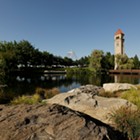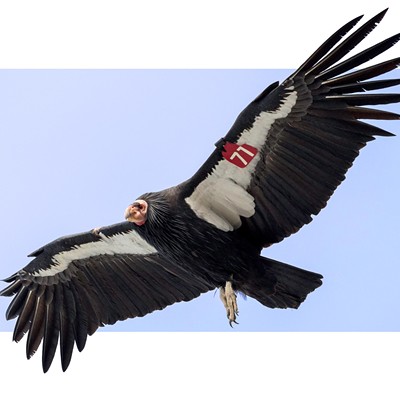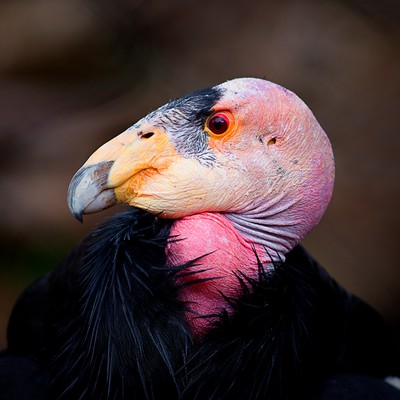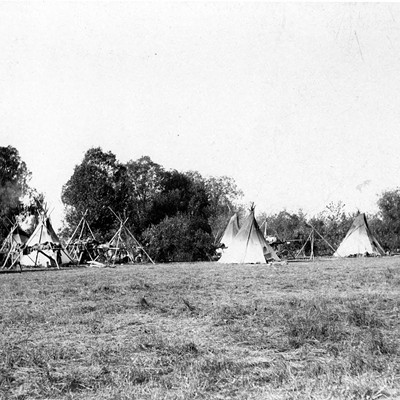About a year ago, I received an e-mail from an unknown sender with the suffix of nasa.gov. I didn't know anyone at NASA, so I hesitated for a moment, suspicious of spam, but then gave into temptation and clicked it open. Lines of color began slowly filling my screen as pixels of a photograph stuttered across my dial-up connection. Tufts of gray hair gradually emerged, then a pair of blue eyes behind rimless glasses, followed by the nose and mustache of a pleasant-looking gent wearing small orange earplugs. His head was framed by a green porthole cover on the right and the edge of an instrument panel on the left. As more of the picture flowed onto the screen, the cover of a book I had written about the explorer David Thompson appeared in the man's hand. Behind him, the porthole revealed a small circle of deep blue etched with a skein of cirrus clouds that looked very far away.
"I'm writing to let you know," the message began, "that your book Sources of the River has been doing some traveling." It was signed "John Phillips, NASA Astronaut aboard the International Space Station."
It slowly dawned on me: I had received an e-mail from outer space.
Over the next few months, as he circled our planet over and over again, Phillips occasionally wired me sharp photographs of landmark lakes along David Thompson's routes in the Inland Northwest. When I asked if he might want to visit some of those lakes after he returned to Earth, Phillips replied we could probably work something out -- a Coeur d'Alene company called Unitech Composites supplied the space program with a system for transporting booster rocket engines, and he occasionally visited their plant.
This spring, Phillips did indeed come to talk to the people at Unitech. On his way through Spokane, I met him at the Northwest Museum of Arts & amp; Culture, where he thrilled the staff by presenting them with a signed photograph of Spokane from space. During a turn through the David Thompson exhibit currently on display at the MAC, Phillips talked about his own experiences as an explorer of the universe. Pausing in front of a case of 19th-century surveying instruments, he reflected on the connections between NASA's space program and the Age of Exploration, and about his admiration for luminaries of that time such as Captain James Cook, Alexander Mackenzie, Lewis and Clark and David Thompson.
"These guys had the best instruments, the latest information, that their time had to offer, and they figured out how to put them to use," he said.
Phillips believes that explorers of any epoch share two important elements: utilization of available technology and a driving curiosity. To those shared traits, I would add the kind of focus and persistence that appear in the life stories of all true explorers. And by those measures, Phillips fits right into that company.
Phillips grew up in the Southwest. His dad was a flying buff who spent many hours touring his kids through local airports. Some of that enthusiasm must have worn off, because after graduating from the Naval Academy in 1974 with degrees in math and Russian, John became a Navy pilot. For the next 10 years, he flew A-7 Corsairs and CT-39 Sabreliners from bases on land and sea.
Phillips always had a serious interest in space, and at age 25 he began applying to NASA's astronaut program. At first he was not accepted, and in 1982 he left the Navy to pursue an advanced degree in space plasma physics from UCLA. There Phillips focused on the sun and space environment, and after receiving his doctorate in 1987 he moved on to Los Alamos National Laboratory in New Mexico, where he published numerous scientific articles on a variety of heavenly bodies. His wife Laura's job as an international stewardess allowed the couple to hike, paddle and ski in faraway places, from New Zealand to the Himalayas. During this time, Phillips continued to fly A-7s for the Naval Reserves, and it was from the air that he became aware of the attractions of the Inland Northwest and began vacationing in the region. He also kept submitting an annual application to the space program, and in 1996, at age 45, he was finally selected -- NASA's oldest new astronaut ever.
Phillips thrived on the rigorous variety of NASA training. From a National Outdoor Leadership Program team session in the Grand Tetons to a stint in the Canadian Arctic in February that involved living in an old-fashioned canvas wall tent and wearing all-wool gear, he learned to deal with cramped spaces and to take the unexpected in stride.
During this period, he occasionally flew with fellow astronaut and Cheney native Michael Anderson, whom Phillips described as "the most gentlemanly gentleman I ever had the privilege of meeting."
In the spring of 2001, Phillips got his first taste of outer space on a 12-day mission aboard the shuttle Endeavor, where he coordinated the activities of crew members who were performing space walks to install the vehicle's robotic arm. His next assignment was as a backup crew member on Mission 7 of the International Space Station. Because much of the traffic for that cooperative program is funneled through the Russian space program, he underwent long-term training on their turf.
Over the course of more than three years, Phillips took part in 18 different training sessions at various Russian facilities. He would fly into Moscow and drive east toward their main headquarters, into an endless mixed forest of pine, birch and larch that reminded him of the tree cover in northeastern Washington. His partner there was Sergei Krikalev, a legendary Russian cosmonaut who had already made five trips into space, including three extended missions. In time, Krikalev was named as commander of the 11th expedition of the International Space Station, and Phillips was tapped to serve as the mission's flight engineer.
Phillips' experiences in Russia gave him a deep appreciation for the resourcefulness of the Soviet program, which comes at the world of space exploration from a very different perspective than NASA. He rediscovered his love of the Russian language and pursued it until he was fluent enough to absorb dozens of Russian technical manuals, as well as Tolstoy's great novel War and Peace in its original form. "After that three-and-a-half years," Phillips says, "six months in space was almost easy."
Sergei Krikalev and John Phillips launched from the Baikonur Cosmodrome in Kazakhstan on April 14, 2005, riding into space on the Soyuz TMA-6 vehicle. Two days later, they docked with the International Space Station to begin their long stint of continuous exploration. The numbers chalked up by Expedition 11 of the ISS are almost impossible for earth-bound humans to comprehend: The two men circled the earth more than 2,500 times between April and October 2005; the station orbited on a continuous angled pathway, like a spiral peel off an apple, that topped out at 51.5 degrees of latitude in both the northern and southern hemispheres; the craft attained a maximum speed of more than 17,000 miles per hour and maintained an altitude of around 200 nautical miles; all told, their epic journey covered more than 70 million miles.
It's hard not ask Phillips question after question after question about such an adventure. He answers them all patiently, practically, with an eye for detail and many flashes of humor, as if he's still rather amazed at the whole thing himself.
"They kept us pretty busy up there," Phillips admits. The International Space Station is big -- the array of four solar panels atop the complex is longer than a football field -- and requires a constant run of routine maintenance. The two-man crew was also responsible for monitoring a host of new and ongoing scientific experiments that covered a broad range of disciplines. Phillips also performed his first spacewalk during the mission, donning a Russian suit to drift out of the Pirs Airlock.
One of the most dramatic moments of the expedition came during the visit of the space shuttle Discovery, which was making the first shuttle flight after the Columbia tragedy. Addressing concerns about possible tile damage to the shuttle's underbelly, Phillips and Krikalev meticulously studied the Discovery from every possible angle, and their spectacular photographs appeared in media sources all over the world.
But it is often the small particulars of space flight that provoke the most questions. The first thing many people wonder about (after the inevitable questions about going to the bathroom) is the physical effect of zero gravity: How can you spend six months in space without coming back as a limp noodle? The answer is that scientists have come up with a three-pronged exercise routine that involves aerobic workouts on a stationary bicycle, resistance with simulated weights and impact by running on a treadmill. By engaging in all three types of exercise for a total of two hours every day, Phillips actually gained lean muscle mass during his time in orbit.
Phillips' eyesight did deteriorate a bit during the flight. Zero gravity's effects on the fluid dynamics of eyeball, brain and spinal fluid are still being studied, but his nearsightedness may also have been due to a natural combination of aging and being shut up in a small space, a syndrome described during World War II as "submariner's myopia."
Another realm of ongoing study involves space sickness, which is related to, but not exactly the same, as car, air and sea sickness. All involve a delicate interplay between different systems of balance within the body, and while Phillips never had any problems with motion sickness during his flights, he did tell stories of people throwing up in space that may not have been so funny at the time. Since returning to earth, Phillips has experienced the back pain that comes with vertebrae responding to gravity, but it has not bothered him to the extent that some astronauts feel it.
At a designated point in every day's schedule, each astronaut would retire to his TESS, a small sleeping quarters, and zip himself into a silvery sleeping bag that was velcroed to a bar to prevent it from floating away. "Sleeping is great in space," Phillips recalls, "but I hardly ever dreamed." He usually snoozed for about seven hours, the same amount of time he likes to sleep on earth.
What about the mental aspects of space travel? Six months seems like a long time to be circling in cramped quarters with one other person. There was no Internet connection, but the astronauts could write and receive e-mails indirectly. NASA requested that Phillips keep a journal occasionally so that staff psychologists could monitor his state of mind. Phillips was never at a loss for things to do, even outside the rigorous work schedule, when there was time built in for simple relaxation.
"I took three books with me up there," John said. "The Thompson book [Sources of the River], the journals of Alexander Mackenzie -- you can tell I like to read about explorers -- and Walt Whitman's Leaves of Grass. But in the long run, I spent a lot more time just looking out the window."
Window gazing traditionally becomes the favorite leisure activity of any astronaut. From a height of 200 miles, you cannot see the entire Earth at once, but an astronaut can identify oceans and continents, a surprising number of topographical features, all the cities and their bright lights, as well as delicious dark spaces like the Gobi and Sahara deserts, the Amazon and the far north. Phillips was able to view some of the atmospheric wonders that he had studied at UCLA, from lightning storms to the northern lights -- from above.
Both Phillips and Krikalev took a lot of photographs of the Earth as they went around it. They had stock Nikon cameras with a variety of lenses that ranged up to a magnification of 800 millimeters. Krikalev, who grew up in Saint Petersburg, tended to concentrate on large cities and architectural landmarks. One of his shots, taken with a long lens from a slanted perspective, shows St. Petersburg in clear view with the Gulf of Finland and the entire Scandinavian Peninsula trailing off around the curve of the planet. The scene is bathed in the golden glow of an extended sunset.
John, on the other hand, liked to focus straight down on places he knew. He and his wife had purchased a plot of land a few years ago near Lake Pend Oreille, and he found himself watching as the familiar shore rolled into view. He became intrigued with what he calls "the great lakes" of the Inland Northwest -- Pend Oreille, Priest, Coeur d'Alene and Flathead -- and he managed to photograph a full-frame overhead image (reproduced in this issue) of each of them.
In early October 2005, after Phillips and Krikalev had spent almost six months in orbit, the Soyuz TMA-7 returned to the International Space Station with a replacement crew. This time, the third seat of the craft had been purchased by an American engineer who owned a successful high-tech sensor business. The American had gone through a year of tough training in Russia and helped finance the Soviet space program in exchange for the trip of a lifetime. The three newcomers came aboard with new supplies and equipment, and the five men shared the station for several days while exchanging information. On Oct. 10, Phillips, Krikalev and the visiting American boarded Soyuz for their return to Earth.
Their flight plan aimed for a spot on the plains of Khazakhstan. Just before the parachuting craft hit the ground, four retro-rockets blasted off to provide a "soft landing" for the passengers. The vehicle came down perfectly on its end, then slowly tilted down on its side. Phillips scrambled out of his harness restraints and up to the hatchway, crawled out and gratefully accepted support from a medic on each arm as he made his first walk across solid ground in half a year.
"I was a little dizzy," he recalled of those steps in Kazakhstan. "But I remember thinking it looked just like Eastern Washington -- all bunchgrass, but not quite as hilly."
Phillips's excitement about the International Space Station is infectious, and his time in space has given him a broad perspective on many aspects of life back on Earth. After our visit to the MAC last month, we walked along the Spokane River for a while, watching the runoff from a big snow year, talking about ski hills all around the region, and discussing good places for Phillips to paddle the kayak that he currently uses to ply the bayous around Houston.
Phillips would like to make one more foray into space, but when his flying days are over, he and his wife plan to retire to the Inland Northwest. You get the feeling that his explorer's curiosity and vibrant focus will serve him well in either place.



















